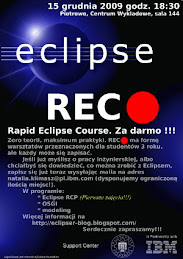After adding GMF to your Eclipse, new wizard appears in "File -> New..." as well as in .ecore file context menu. It initializes ecore diagram out of normal .ecore and lets you drag classes around, make connections, and all you were always dreaming about. Thanks to that, diagram editor and ecore editor can be used simultaniously, as they work on the same file and changes are immediately visible in both of them.

So that is EMF model diagram editor. Despite the fact, we've got EMF inside, it's still very nice class diagram editor, maybe more conformant with XSD than UML, but enough for most cases.
Another diagramming equipment comes bundled in UML2Tools. This feature grows on UML2 model implemented in EMF, a part of Eclipse Modelling top-project. Besides classes, it supports creating activity, component, profile and state machine diagrams. We're still waiting for first release, but there is already a loot to look at:

What i was most surprised about, is that this diagrams, or rather designed UML model, can be also used to build ecore (see the image below). Unfortunately right now, conversion is one-way only, which finally makes you end up with ecore model, uml model and uml diagram. Good news is that, first UML2Tools release is planned for June.


